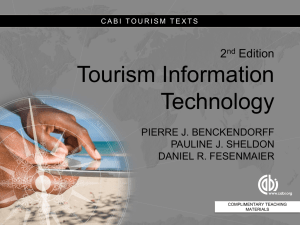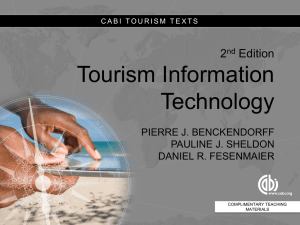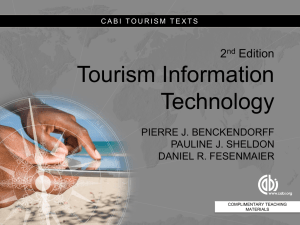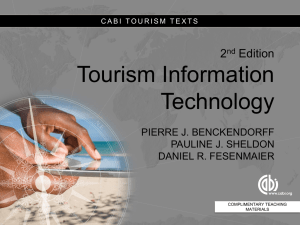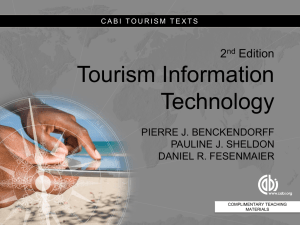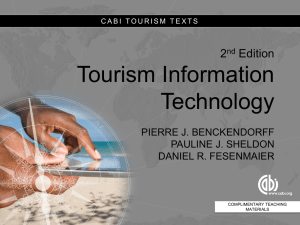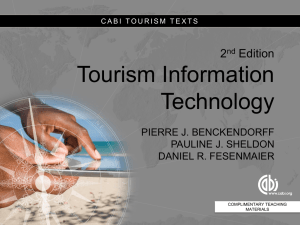Chapter 8
advertisement
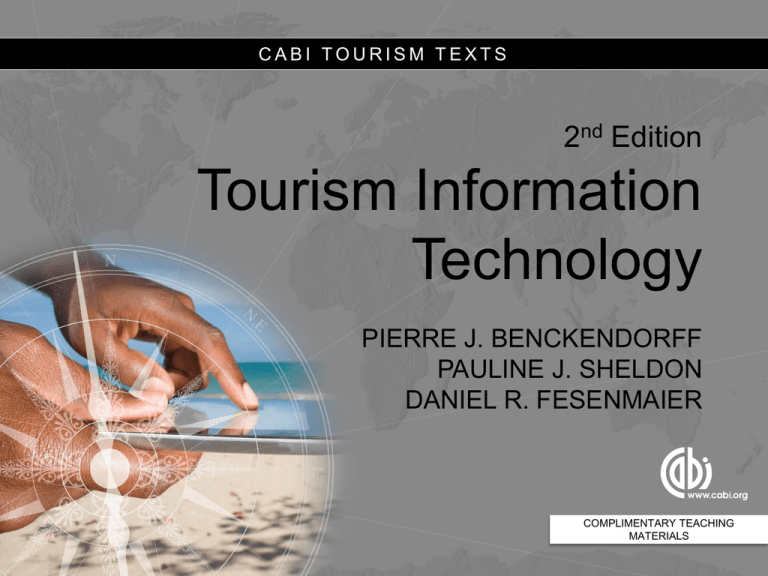
CABI TOURISM TEXTS 2nd Edition Tourism Information Technology PIERRE J. BENCKENDORFF PAULINE J. SHELDON DANIEL R. FESENMAIER COMPLIMENTARY TEACHING MATERIALS CABI TOURISM TEXTS Chapter 8 Surface Transport and Information Technology CABI TOURISM TEXTS Chapter 8 Learning Objectives After studying this chapter you should be able to: 1. explain the components an Intelligent Transportation System (ITS) and how they are applied to surface transport; 2. describe the different applications in road, rail and water transport; and 3. evaluate how technology facilitates the connection of systems in intermodal transport. CABI TOURISM TEXTS Key Concepts Automated Traffic Management Systems (ATMSs) Automated Vehicle Location (AVL) Car/bike sharing Driverless cars e-tolls and Electronic Road Pricing (ERP) Geographic Information System (GIS) Intelligent Transport System (ITS) Smart cars Vehicle Information & Communication System (VICS) 4 CABI TOURISM TEXTS Intelligent Transport Systems (ITSs) A broad range of information and communications technologies that improve the safety, efficiency, and performance of the transport system. ITSs can help reduce congestion, improve mobility, save lives and optimize our existing infrastructure. Industry Insight: Qatar’s ITS tunnel management systems incident detection and weather sensors lane and speed control signs connected vehicles and car-sharing systems automated payment mechanisms intelligent parking management 5 CABI TOURISM TEXTS ITS Benefits detecting hazards and informing drivers before they are visible; keeping vehicles at a safe distance; allowing vehicles to communicate with infrastructure; route planning and warnings of congestion and accidents; keeping drivers informed of the local speed limit; monitoring drivers for signs of fatigue; real time service information for public transport users; smart and seamless ticketing solutions; integrating public transport into traffic management systems; improved efficiency has obvious benefits for the environment; & reliable real-time travel and traffic information. 6 Source: European Telecommunications Standards Institute (2012) 7 CABI TOURISM TEXTS Information Transfer in ITSs 1 2 In-vehicle systems Vehicle-to-vehicle systems Vehicle-to-infrastructure systems 3 8 CABI TOURISM TEXTS ITS Applications Automated Traffic Management Systems (ATMSs): manage the flow of road traffic using a variety of technologies. e-tolls: electronic toll booths deduct toll payments without stopping. Electronic Road Pricing (ERP): requires drivers to pay different tolls at different times. Traveler Information Systems: provide online, realtime information on road conditions. Route guidance system: helps a driver navigate the best routes to a given location. 9 CABI TOURISM TEXTS Smart cars Vehicle Technology Driverless cars Connected cars 10 CABI TOURISM TEXTS Vehicle Rentals & Taxis IT Applications Reservation systems Vehicle inventory control Car and bicycle sharing systems Ride-sharing systems 11 CABI TOURISM TEXTS Rail Transport IT Applications Web-based computer reservation systems GDS connectivity Smartphone apps Smart cards Electronic ticketing systems Departure control systems Inter-modal booking systems 12 CABI TOURISM TEXTS Water Transport IT Applications Computerized reservation systems Cruise booking systems (e.g. CruiseMatch) Electronic ticketing systems Guest technologies (smart cards, on board navigation, mobile apps, entertainment, tablets) Global Navigation Systems and Maritime Distress and Safety Systems Point of sale systems Inventory control systems 13 CABI TOURISM TEXTS Integrated Public Transport Systems IT Applications Intermodal systems Smart cards and contactless ticketing using RFID or NFC (e.g. London’s Oyster Card) 14 CABI TOURISM TEXTS Discussion Questions 1. Which of the transport developments discussed in this chapter are most important for tourists (as opposed to residents)? Why? 2. Explain what is meant by collaborative mobility. Describe different modalities for this type of transport. Are there any disadvantages that would prevent you from using this type of transport as a tourist? What are its benefits? 3. Research the various national rail networks other than those in Europe. What type of IT applications are they using? How easy is it for passengers to make cross-border reservations in that part of the world. 4. Spend some time researching driverless cars more. What do you see as the real advantages? How relevant are these advantages to tourists? Are there some types of tourists for which they would not be relevant? 15 CABI TOURISM TEXTS Useful Websites Intelligent Transportation Society of America www.itsa.org Intelligent Transport Systems Australia www.its-australia.com.au CruiseMatch www.cruisematch.com Intelligent Transportation Systems Society www.sites.ieee.org/itss US Dept. of Transportation Research & Innovative Technology www.its.dot.gov ABI Research www.abiresearch.com/research/se rvice/intelligent-transport-systems/ ERTICO www.ertico.com The World Carshare Consortium www.ecoplan.org/carshare 16 CABI TOURISM TEXTS Case Study: Zurich’s Transport System Intelligent Transport System. Consolidated ticketing for 313 trams, 80 trolleybuses and 261 urban buses. ITS Applications: automated vehicle location; operations management including incident management; traffic signal priority; electronic fare collection (smart cards); real-time passenger information pre-trip, at stations and in vehicles; automated passenger counting; timetabling; and vehicle and driver scheduling. 17

